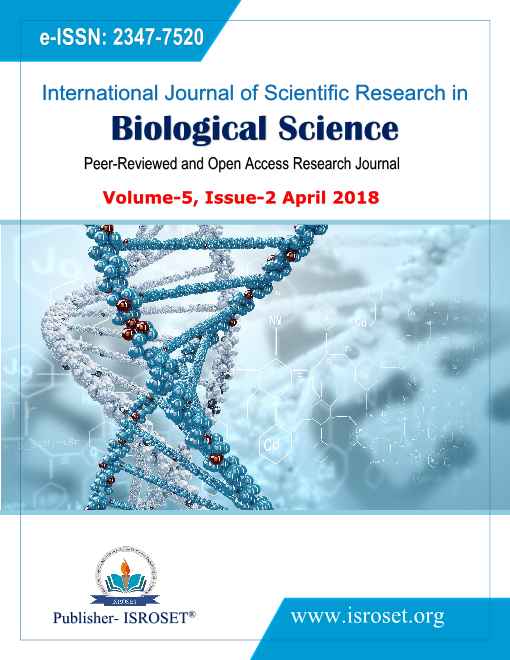Antibacterial effects of Citrus limon peel extract on human pathogenic bacteria with special reference to Urinary Tract Infection
Keywords:
Citrus limon, Human pathogens, UTI, antimicrobial agentAbstract
Urinary tract infections (UTI) are the most common pathogenic infections, specially found in working ladies as well as seen in men and lead to many difficult problems. As the microorganism are resistant day by day from antibiotics. The main objective of this study is evaluated the antimicrobial activity and future prophylactic potential of the Citrus limon peel against strains of human pathogenic bacteria. Phytochemical analysis of citrus fruits shows that they are rich source of flavanones and many polymethoxylated flavones, which are found very rare in other plants, have very strong antibacterial activity. Antimicrobial analysis was done by using agar well diffusion method. The result was found that, the peel extract of lemon were inhibited the growth of Escherichia coli and Staphylococcus aureus as well as Bacillus substilis which show the resistance against nalidixic acid, co-trimoxazole and nitrofuranation antibiotics. On the basis of the present finding lemon peel extract might be a good candidate in the search for a natural antimicrobial agent and can be considered to be as equally potent as the antibiotics, such as, ciprofloxacin.
References
N. Sharma, A.M.Jana, N. Pathak, C.Singh and P.Singh, “A preliminary study on antimicrobial effects of ethanolic extract of Psidium guajava leaves on bacteria isolated from urinary tract infection with special reference to Escherichia coli and Staphylococcus aureus” International journal of biotechnology and biochemistry, Vol 13, Number 2, pp.183-189.(2017)
A. Kumar A, N. Jhadwal, M. lal, M. Singh, “Antibacterial activity of some Medicinal Plants used against UTI causing Pathogens”. Int. Jr. of Drug Development & Research, Vol. 4 Issue 2.(2012)
T.M. Hootan, “Urinary tract infection in adults” In: Johnson R.J., Feehally J, (Eds). Comprehensive clinical nephrology, 2nd ed, London: Mosby, , 731-744. (2003).
D. Srinivasan, N.Sangeethan, T. Suresh, P. Lakshmana and Permalsamy “Antibacterial activity of Neem (AzadirachTA INDICA) and Tamarind (Tamarindus Indica) leaves. Asian Jr. of Microbiol Biotech & Env. SC. Vol.3, No. (1-2):2001:67-73.3( 2001).
H. Salih, A.M. Abass, “Study of the fruit peels of Citrus sinesis & Punica granatum”. Journal of Babylon university,243-342.(2003)
T. Hiroyuki., K. Tetsuro K, Masayuki, K. Afework, O.Fusao. “Antimicrobial activity of citrus fruits juice against vibrio species”. 52(2): 157-160.(2006)
A. Mathur, S.Verma, R.Purohit, V. Gupta, V.K. Prasad, D. Mathur, S.K. Singh and S. Singh, “Evaluation of in vitro antimicrobial & antioxidant activity of peels & pulp of some citrus species”. International journal of biotechnology & biotherapeutics, (1) 2:2229-2278.(2011).
M. Chandra, “Antimicrobial Activity of Medicinal Plants against Human Pathogenic Bacteria”, Int. J. Biotechnol. Bioengg. Res., 4(7), pp. 653-658.(2013).
M.A.K. Saadi, H. Salih, A.M.Abbas, “Study of the fruit peels of Citrus sinesis & Punica granatum” . journal of Babylon university,3(9):243-342.(2003).
A. Pandey, I. Ali, K.S. Butola, T. Chatterji, “Isolation and characterization of actinomycetes against pathogen”, Inter. J. appl. Biol. Pharma. Technol., 2(4), pp. 384-392. (2011)
F. Aqil, M.S. Khan, M. Owais, I. Ahmad, “Effects of certain bioactive plant extracts on clinical isolates of beta-lactamase producing methicillin resistant Staphylococcus aureus”, J. Basic Microbiol.45, pp. 106-114.(2005).
A. Nostro, L.Cellini, S. Bartolomeo, “Effects of combining extracts (from propolis or Zingiber officinale) with clarithromycin on Helicobacter pylori”, Phytotherapy Res. 20(3), pp. 187-190.(2006).
S. Gopalkrishnan, S. George, P.J. Benny, “Antimicrobial effect of Punica grantum on pyogenic bacteria” J. Pharma. Biomed. Sci. 3(6).(2010).
B.Mahesh and S. Satish, “Antimicrobial activity of some important medicinal plant extract against plant and human pathogens”, World J. of Agri. Sci. 4(5), pp. 839-843.(2008)
T.S. David and M.S. Vrahas, “Perioperative lower urinary tract infections and deep sepsis in patients undergoing total joint arthroplasty”, J. Am. Acad. Ortho. Sur., 8, pp. 66-74. (2000).
A. Ronald, “The etiology of urinary tract infection: traditional and emerging pathogens”, Dis. Mon., 49, pp. 71–82. (2003).
A.C.Gales, R.N.Jones K.A. Gordon, H.S.Sader, W.W. Wilke, M.L. Beach, M.A. Pfaller, G.V. Doern, “Activity and spectrum of 22 antimicrobial agents tested against urinary tract infection pathogens in hospitalized patients in Latin America: report from the second year of the sentry antimicrobial surveillance program” J. Antimicrobial Chemo., 45, pp. 295-303.(2002).
Hiroyuki, (2006). “Antimicrobial activity of citrus fruit juice against Vibrio species”. IJCSNS. 52(2):157 – 160.
Downloads
Published
How to Cite
Issue
Section
License

This work is licensed under a Creative Commons Attribution 4.0 International License.
Authors contributing to this journal agree to publish their articles under the Creative Commons Attribution 4.0 International License, allowing third parties to share their work (copy, distribute, transmit) and to adapt it, under the condition that the authors are given credit and that in the event of reuse or distribution, the terms of this license are made clear.







